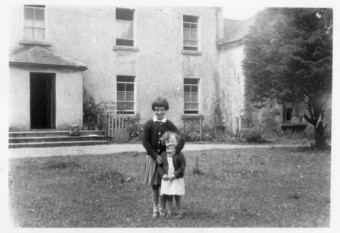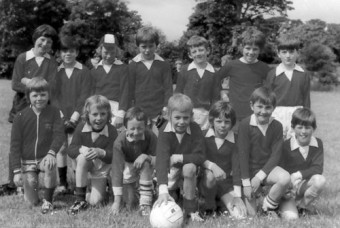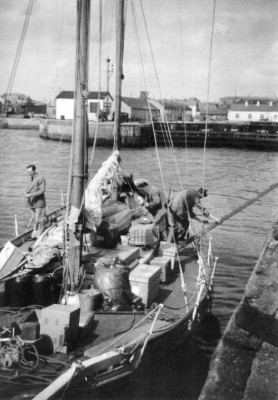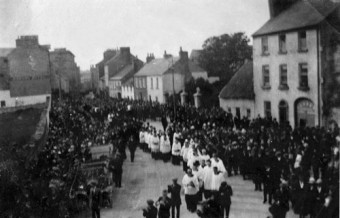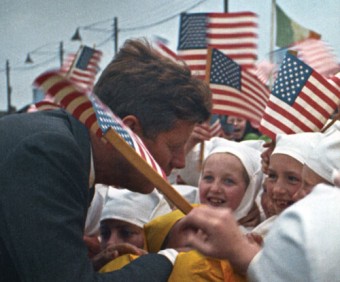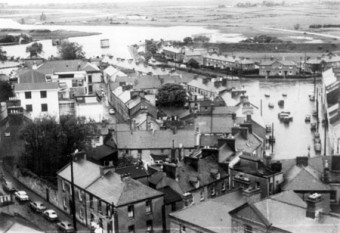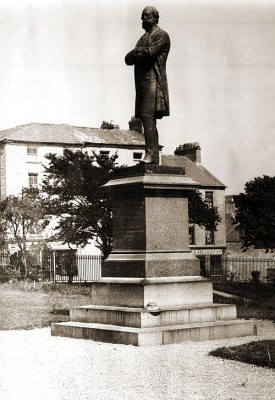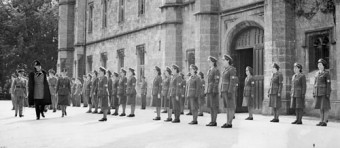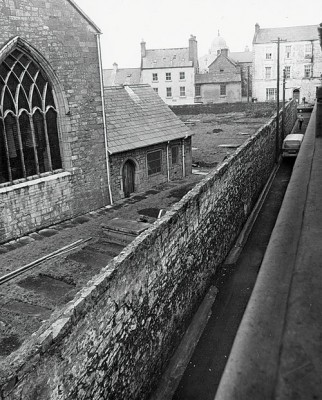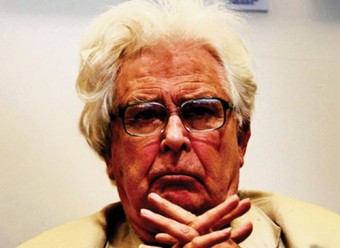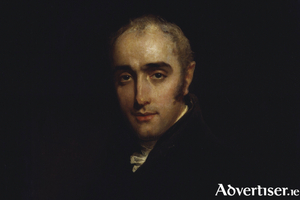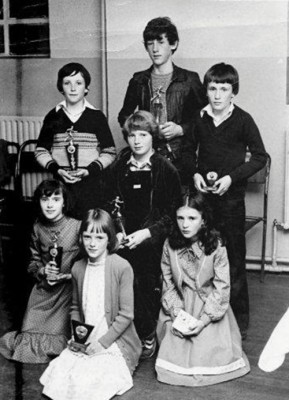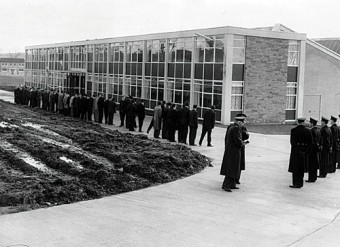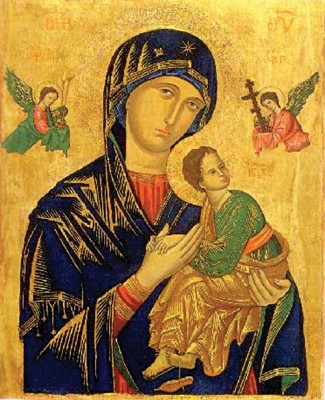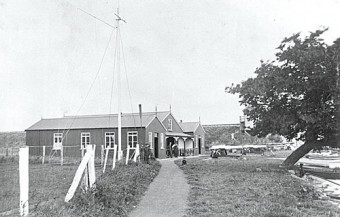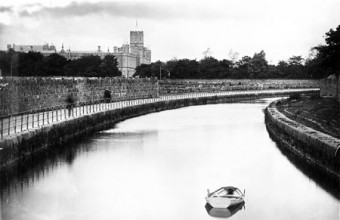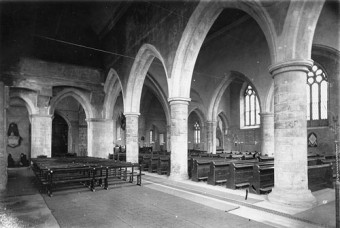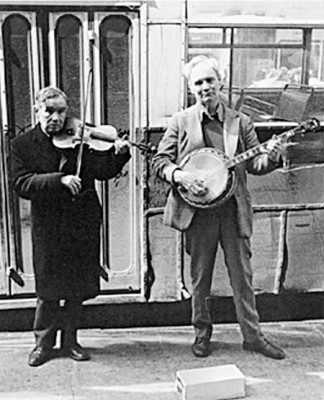Shantallow House
Thu, Dec 09, 2010
Our photograph today shows two young girls, Marie Scanlon and her sister from Shantalla, standing in front of Shantallow house in the mid 1940s. Prior to the building of the council houses we know as Shantalla, this house was more or less surrounded by green fields. At one time the house was owned by a distinguished engineer named William Blood, who was related to the Maunsell family from across the road in Fort Eyre. Blood’s nephew was George Johnson Stoney who was professor of natural philosophy in Queen’s College, Galway, from 1853 to 1857, and who lived in this house during that time. He was a distinguished amateur scientist who worked for a time as Lord Rosse’s astronomer at his large telescope in Birr. Stoney was the person who coined the name ‘electron’. He later became the secretary to the Queen’s Colleges, so he made a significant contribution.
Read more ...Forty years of Highfield Park
Thu, Dec 02, 2010
The area we know today as Highfield Park was originally a place of green fields and rocky granite outcrops and it was ‘out in the country’. There were very few people living there. Mostly situated in the townland of Rahoon (Rath Ún or Ún’s Fort), it was bordered by two of the main roads into Galway, the Taylor’s Hill road and the Rahoon road. There was a small granite quarry there, (near the grounds of St Helen’s) and a couple of stone turrets which probably served as watchtowers.
Read more ...From Galway to New York in 1952
Thu, Nov 25, 2010
The Aisling was a rig kedge which was built in McDonagh’s Boatyard in 1946 by John McNally to a design by AA Pemberthy, who was a district engineer with the ESB. It was intended for Mediterranean cruises. Most of the vessel was of timber cut in County Galway and it also included part of the recently demolished stand at Ballybrit. John McNally unfortunately died before the boat was built, and a man called Tony Jacob from Rosslare bought the half finished vessel. He had gone to school with Fionn and Christopher Darby from Killiney, with Anthony Blyth from Athenry, and with David Webb from Nenagh.
Read more ...That strange English passion for Ireland
Thu, Nov 25, 2010
In the early years of the 20th century the Irish language increasingly was associated with poverty and backwardness. In the national school system, which was established in 1831, children had been beaten with what became known as a ‘tally stick’ if they were caught speaking Irish. Apparently every time a child was heard speaking Irish, a notch was cut on the stick, and the poor child received the same number of blows.
Far from being upset by this, many parents enthusiastically endorsed it. They felt that the future of their children depended on their ability to speak English. Understandably, Ireland experienced a steady decline in native Irish speakers*.
Read more ...Father Michael Griffin
Thu, Nov 18, 2010
Ninety years ago this week, Galway was abuzz with the news that Fr Griffin, a junior curate for the parishes of Bushy Park and Barna, apparently responding to a sick call, went out into the howling gale in the company of three men who were said to have trench coats and rubber boots, and disappeared. The suspicion was that he had been decoyed from his house. It was significant that he did not take the Blessed Sacrament with him. His housekeeper heard very loud knocking as if with the butt ends of revolvers on the front door near midnight, as did one of the neighbours. Apparently Fr Griffin opened his window, spoke briefly to the men, and then left with them shortly afterwards.
Read more ...President Kennedy in Galway
Thu, Nov 11, 2010
Saturday, June 29, 1963 may have been dull and overcast, but the city of Galway presented a colourful spectacle amid scenes of unprecedented enthusiasm. It was covered in Tricolours and the Stars and Stripes, in bunting and banners, in windowboxes of flowers and newly painted buildings. There was a carnival atmosphere. Some 600 gardaí were up early, lining the streets ahead of the crowds that began to arrive from 7am. There were journalists here from all over the world to cover the event.
Read more ...Watery Woodquay
Thu, Oct 28, 2010
Most of the area seen in this photograph was once part of a grant of land to Edward Eyre in 1670. It was all originally outside the city walls and was mostly made up of three islands which included St Stephen’s Island and Horse Island.
Read more ...Lord Dunkellin’s statue
Thu, Oct 21, 2010
In 1873 this imposing statue was unveiled in Eyre Square in honour of Lord Dunkellin, son of Lord Clanricarde and heir to the family estates. He had a distinguished military career before being elected MP for Galway City in Parliament. He held the seat for eight years before being elected for the county in 1865. He died in 1867. There was a very large gathering in the Square on the day of the unveiling with lots of toasts and speeches. The sculpture was a very fine one by the distinguished artist John Henry Foley.
Read more ...The Order of Malta in Galway
Thu, Oct 14, 2010
The Order of Malta was founded in the 12th century in Jerusalem to care for Christian pilgrims in the Holy Land and along pilgrimage routes through Christian Europe. Subsequently they were known as the Knights Hospitallers and when they came to Ireland they maintained hospitals for the sick, the poor, and the needy, and hostels for the use of travellers. The order is involved in many charitable activities, the most important being the administration of the Order of Malta Ambulance Corps.
Read more ...College House, a brief history
Thu, Oct 07, 2010
This photograph was originally taken in 1983 as the corporation was preparing to knock down the high wall that ran around St Nicholas’ Collegiate Church and replace it with the railings that had surrounded Eyre Square… one of the better Quincentennial projects that helped improve the face of Galway.
Read more ...A Yorkshire man in Galway
Thu, Oct 07, 2010
On October 22 1959 an unusual play opened at the Royal Court theatre, London; a theatre never afraid to be different. It had after all presented John Osborne’s Look Back in Anger* three years previously - a play which rocked the establishment, and transformed English drama for ever. The critics adored it, it played to full houses every night, and it made lots of money for everyone concerned.
Read more ...John Wilson Croker - the Galwegian who invented conservatism
Thu, Sep 30, 2010
The Tory Party in Britain can count among its leaders Winston Churchill, Harold MacMillan, and Margaret Thatcher, and is now led by the Eton and Oxford educated David Cameron, who hails from Berkshire, a traditional Tory heartland.
Read more ...Castlegar Athletic Club, a brief history
Thu, Sep 30, 2010
The Castlegar Hurling Club ladies’ committee decided to hold a parish sports day on National Children’s Day, Sunday June 8 1975. They enlisted the help of Seán Duffy and Patsy Durnin in the organisation of the event, which turned out to be an outstanding success. As a result, they decided to enter a team of 40 athletes in the County Community Games. Seán Duffy organised training sessions twice a week, a banner and a set of green and white singlets were purchased, and there was great excitement as the big day approached. This excitement reached fever pitch when Ann Fahy won the gold medal in the girls’ under-14 100 metres, and Patricia Grealish brought home a bronze medal in the girls’ under-12 200 metres.
Read more ...Pioneers of industry in Galway
Thu, Sep 23, 2010
There were very few industrial plants in Galway in the 1950s. Galway Textile Printers, known locally as the cotton factory, had just opened; there was the hat factory, and there were some small units around town, but that was it. Then the Lemass era arrived, and there was a change in government policy as the government began to actively encourage industries from abroad to locate here.
Read more ...Is Ms Jennifer Sleeman a bit of a crackpot?
Thu, Sep 23, 2010
I have always thought it strange why so many women feel isolated from the Catholic Church, when it has at its centre a woman, Mary - the Mother of God. It is not right that many women feel they are ‘second class citizens’ within a church that attempts to reach out to all. Surely without Mary, the New Testament would be worthless. Surely after the Nazarene Himself, the Mother of Jesus, who is venerated by the Catholic and Orthodox churches, is the first and greatest saint in heaven. Mary is revered by all Christian churches, and honoured by Islam. At the very first council of the Church, at Ephesus four hundred years after Christ, she was declared to be the Theotokos, Mother of God (the actual God bearer). But even before that her image, holding the Child, was etched into tombs in the Roman catacombs. Being the Theotokos, Mary could have become remote, unreal from the human experience. After all we are told that she was born free from Original Sin, which as a total ‘theological illiterate’ I don’t fully understand; but I accept the logic that if Mary was not the mother of God, then Jesus was not God. I believe that He was. Yet despite the supreme position of Mary many women feel isolated, uninvolved, as if they have no contribution to make.
Read more ...Taibhdhearc na Gaillimhe
Thu, Sep 16, 2010
On the 1820 map of Galway, the site of the Taibhdhearc was part of the then Augustinian Church. When the present church was built in the 1850s the site became derelict. The late Ned Joyce remembered a large tree growing on the site, a tree which stretched across the street to a tenement known as ‘The Windings’. The occupants used to hang their washing on the tree on fine days.
In 1912 the Augustinians built the present building as a parish hall, which functioned as a social club where they put on dramatic productions as well as playing billiards and table tennis, etc. This club became defunct and, in 1928, a committee of 10 under the chairmanship of Dr Seamus O’Beirne took it over and equipped it as a theatre. Their idea, and that of the Government of the time, was to use An Taibhdhearc and An Céad Cath, the Irish speaking army battalion based in Renmore Barracks, as vehicles for the regeneration and promotion of the Irish language in Galway. The committee invited Mícheál Mac Liammóir and Hilton Edwards to produce the first play which was Mícheál’s own Diarmuid agus Gráinne.
Read more ...The Corrib Club
Thu, Sep 09, 2010
“The Galway Corrib Club held their annual regatta on the splendid river of the Corrib at Menlo. The day was as fine as ‘sunshine and pageantry’ could make it, and the ivy-mantled Castle of Menlo, the residence of Sir Thomas Blake, Bart, was decorated with flags of all nations, and waved gracefully in the breeze. There was not a ripple on the bosom of the lake unless what was created by the oars of the several beautiful little crafts which were constantly scudding up and down the river, freighted with some of Nature’s fairest daughters. There was a band in attendance and during the day discoursed some beautiful music. Great credit is due to the commodore, PT Grealy, Esq, and the members of the club for the satisfactory manner in which the whole arrangements were carried out. After five races between four oared gigs, outriggers and punts, the sports of the day terminated with a duck race, which was most amusing. At seven o’clock, the amusements terminated and the delighted spectators returned home, highly pleased with the day’s sport. Although there were places of refreshment, there was not a man to be seen the worse for liquor, so that the whole affair was a complete success.”
Read more ...The Eglinton Canal
Thu, Sep 02, 2010
In 1498, during the mayoralty of Andrew Lynch, an attempt was made to open a passage from the River Corrib along the Sandy River and through land to Lough Atalia, thus connecting the river to the sea.
Read more ...Galway’s rich heritage
Thu, Aug 19, 2010
This photograph of the interior of St Nicholas’ Collegiate Church was originally taken c1890 and was given us by the National Library. The Leper’s Gallery can be seen over the arches to the left.
Read more ...The Dunne brothers busking in Galway
Thu, Jul 29, 2010
Busking is the practice of performing in public places for tips or gratuities. The earliest buskers in Galway were probably singers who would sing on the street, and then knock on doors in the hope of getting money or food. In the early 20th century, Johnny Doran and his family would move around playing in different places, including the races, and then in the evening outside the Imperial Hotel. Paddy Philbin, who later became a dancing master, would dance for him and they drew big crowds. Later came the Reaney brothers who played in various locations in Galway city and county.
Read more ...